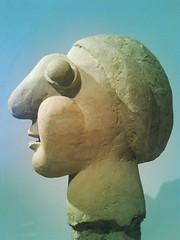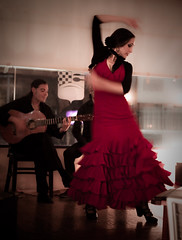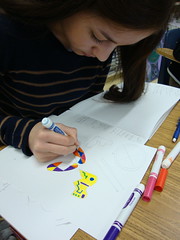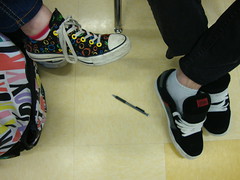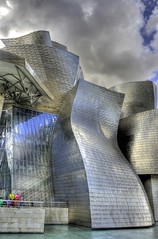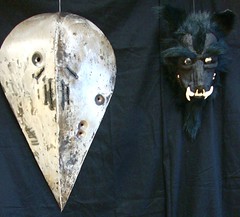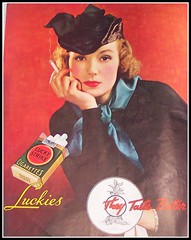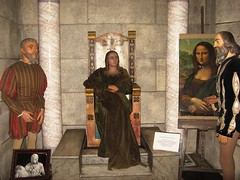Make a map and briefly identify the location and significance of each of the following -
1. Espana
2. France
3. Mediterranean
4. Basque Region
5. Pamplona
6. Guernica
7. Madrid
8. Malaga
9. Andalusia
10. Barcelona
11. Paris
12. Provence region / includes the Cote d'Azur or Riviera
Above: Picasso from the Marie-Therese period on the shore of the Med.
Monday, January 30, 2012
Flamenco! the Soul music of Spain
Flamenco is a genre of music, song and dance from the Spanish region of Andalusia, says Wikipedia.
It is noted for its energetic, staccato style. It grew from Andalusian music, song and dance styles and the song and dance of the local Romani people.[1][2][3]
The cante (singing), toque (guitar playing), dance and palmas (handclaps) are the principal facets of flamenco.
George Borrow asserted the word flemenc [sic] is synonymous with "gypsy".[citation needed] Blas Infante, in his book Orígenes de lo flamenco y secreto del cante jondo, suggests the word may derive from Andalusian Arabic fellah mengu, "Escapee Peasant", referring to the Muslim Andalusians (Moriscos) who stayed in Spain and mixed with the Romani newcomers when the Spanish reclaimed their land.
It is noted for its energetic, staccato style. It grew from Andalusian music, song and dance styles and the song and dance of the local Romani people.[1][2][3]
The cante (singing), toque (guitar playing), dance and palmas (handclaps) are the principal facets of flamenco.
George Borrow asserted the word flemenc [sic] is synonymous with "gypsy".[citation needed] Blas Infante, in his book Orígenes de lo flamenco y secreto del cante jondo, suggests the word may derive from Andalusian Arabic fellah mengu, "Escapee Peasant", referring to the Muslim Andalusians (Moriscos) who stayed in Spain and mixed with the Romani newcomers when the Spanish reclaimed their land.
Picasso / Cubism project
Sketch, color and cut out at least 5 symbols typical of use by Picasso in his early career.
Include a musical instrument and harlequin figure.
Paste them to a background on which we see a 360 degree border that is composed of writing - factoids from the Picasso bio.
5 pts.
Include a musical instrument and harlequin figure.
Paste them to a background on which we see a 360 degree border that is composed of writing - factoids from the Picasso bio.
5 pts.
Saturday, January 28, 2012
"Guernica," iPhone, "Blue Nude," iTunes, "Les Demoiselles d'Avignon," iMac
Details (calligraphy lessons, bullfights). Examples (Zen Buddhism, bombs and terror).
Essays in the recent comparison of Steve Jobs (1955 - 2011) and Pablo Picasso (1881 - 1973) were succinct and shiny.
But too many writers went for the glistening generalities ("magical and unbelievable") and were seriously short on details such as "Guernica," iPhone, "Blue Nude," iTunes, "Les Demoiselles d'Avignon" and iMac.
Essays in the recent comparison of Steve Jobs (1955 - 2011) and Pablo Picasso (1881 - 1973) were succinct and shiny.
But too many writers went for the glistening generalities ("magical and unbelievable") and were seriously short on details such as "Guernica," iPhone, "Blue Nude," iTunes, "Les Demoiselles d'Avignon" and iMac.
Saturday, January 21, 2012
Comparison project: Steve Jobs and Pablo Picasso; due Jan 26
There were so many ways in which these pioneering thinkers, Jobs and Picasso, were alike.
The illustrated project, for 15 pts:
1. influential elements of their early lives
3 photos each with brief captions.
2. 3 series of Picasso's art and 3 products managed by Jobs - with illustrations.
3. Brief essay offering your thoughts on 3 ways in which they were alike. Add a quote from an authority on comparing the 2 men to add strength to your essay.
Cake frosting title. Salty opening. Include titles of the art.
The illustrated project, for 15 pts:
1. influential elements of their early lives
3 photos each with brief captions.
2. 3 series of Picasso's art and 3 products managed by Jobs - with illustrations.
3. Brief essay offering your thoughts on 3 ways in which they were alike. Add a quote from an authority on comparing the 2 men to add strength to your essay.
Cake frosting title. Salty opening. Include titles of the art.
Friday, January 20, 2012
Artistic source material: getting out of town with Steve Jobs
Steven Paul Jobs (/ˈdʒɒbz/; February 24, 1955 – October 5, 2011)[4][5] was an American businessman and inventor widely recognized as a charismatic pioneer of the personal computer revolution, says Wikipedia.[6][7]
He was co-founder, chairman, and chief executive officer of Apple Inc. Jobs was co-founder and previously served as chief executive of Pixar Animation Studios; he became a member of the board of directors of The Walt Disney Company in 2006, following the acquisition of Pixar by Disney.
Following high school graduation in 1972, Jobs enrolled at Reed College in Portland, Oregon. Although he dropped out after only one semester,[22] he continued auditing classes at Reed, while sleeping on the floor in friends' rooms, returning Coke bottles for food money, and getting weekly free meals at the local Hare Krishna temple.[23] Jobs later said, "If I had never dropped in on that single calligraphy course in college, the Mac would have never had multiple typefaces or proportionally spaced fonts."
He traveled to India in mid-1974[25] to visit Neem Karoli Baba[26] at his Kainchi Ashram with a Reed College friend (and, later, an early Apple employee), Daniel Kottke, in search of spiritual enlightenment.
Jobs left India after staying for seven months[27] and returned to the US ahead of Daniel Kottke,[24] with his head shaved and wearing traditional Indian clothing.[28][29] During this time, Jobs experimented with psychedelics, calling his LSD experiences "one of the two or three most important things [he had] done in [his] life".[30] He also became a serious practitioner of Zen Buddhism, engaged in lengthy meditation retreats at the Tassajara Zen Mountain Center, the oldest Sōtō Zen monastery in the US,[31] considered taking up monastic residence, and maintained a lifelong appreciation for Zen.[32] He later said that people around him who did not share his countercultural roots could not fully relate to his thinking.[30]
Please continue reading this vivid bio at Wikipedia.
He was co-founder, chairman, and chief executive officer of Apple Inc. Jobs was co-founder and previously served as chief executive of Pixar Animation Studios; he became a member of the board of directors of The Walt Disney Company in 2006, following the acquisition of Pixar by Disney.
Following high school graduation in 1972, Jobs enrolled at Reed College in Portland, Oregon. Although he dropped out after only one semester,[22] he continued auditing classes at Reed, while sleeping on the floor in friends' rooms, returning Coke bottles for food money, and getting weekly free meals at the local Hare Krishna temple.[23] Jobs later said, "If I had never dropped in on that single calligraphy course in college, the Mac would have never had multiple typefaces or proportionally spaced fonts."
He traveled to India in mid-1974[25] to visit Neem Karoli Baba[26] at his Kainchi Ashram with a Reed College friend (and, later, an early Apple employee), Daniel Kottke, in search of spiritual enlightenment.
Jobs left India after staying for seven months[27] and returned to the US ahead of Daniel Kottke,[24] with his head shaved and wearing traditional Indian clothing.[28][29] During this time, Jobs experimented with psychedelics, calling his LSD experiences "one of the two or three most important things [he had] done in [his] life".[30] He also became a serious practitioner of Zen Buddhism, engaged in lengthy meditation retreats at the Tassajara Zen Mountain Center, the oldest Sōtō Zen monastery in the US,[31] considered taking up monastic residence, and maintained a lifelong appreciation for Zen.[32] He later said that people around him who did not share his countercultural roots could not fully relate to his thinking.[30]
Please continue reading this vivid bio at Wikipedia.
Wednesday, January 18, 2012
Guernica, the Basques and the Basque city of Bilbao, known for its Guggenheim Museum
This limestone- and titanium tile–clad Getty museum looks like a huge, silvery fish, and connects the city of Bilbao with its river. Architect Frank Gehry meshed many visions. To him, the building's multiple forms jostle like a loose crate of bottles. They also evoke sails heading out to sea.
Gehry keeps returning to his fish motif, reminding visitors that, as a boy, he was inspired by carp...even taking them into the bathtub with him. The building's skin — shiny, metallic, fish-like scales — is made of thin titanium, carefully created to give just the desired color and reflective quality.
A great way to really enjoy the exterior is to take a circular stroll up and down each side of the river along the handsome promenade and over the two modern pedestrian bridges.
Guarding the main entrance is artist Jeff Koons' 42-foot-tall West Highland Terrier. Its 60,000 plants and flowers, which blossom in concert, grow through steel mesh. A joyful structure, it brings viewers back to their childhood...perhaps evoking humankind's relationship to God...or maybe it's just another notorious Koons hoax. One thing is clear: It answers to "Puppy."
The atrium is clearly the heart of the building, pumping visitors from various rooms on three levels out and back, always returning to this central area before moving on to the next. Only the floor is straight. The architect invites you to caress the sensual curves of the walls. Notice the sheets of glass that make up the elevator shaft: They overlap like scales on a fish. The various glass and limestone panels are each unique, designed and shaped by a computer — as will likely be standard in constructing the great buildings of the future.
From the atrium, step out onto the riverside terrace. The shallow pool lets the river lick at the foundations of the building. Notice the museum's commitment to public spaces: On the right, a grand and public staircase leads under a big green bridge to a tower designed to wrap the bridge into the museum's grand scheme.
This museum is part of the Guggenheim "family" of museums; the collection rotates among the sister Guggenheim galleries in New York, Venice, and Berlin.
Gehry keeps returning to his fish motif, reminding visitors that, as a boy, he was inspired by carp...even taking them into the bathtub with him. The building's skin — shiny, metallic, fish-like scales — is made of thin titanium, carefully created to give just the desired color and reflective quality.
A great way to really enjoy the exterior is to take a circular stroll up and down each side of the river along the handsome promenade and over the two modern pedestrian bridges.
Guarding the main entrance is artist Jeff Koons' 42-foot-tall West Highland Terrier. Its 60,000 plants and flowers, which blossom in concert, grow through steel mesh. A joyful structure, it brings viewers back to their childhood...perhaps evoking humankind's relationship to God...or maybe it's just another notorious Koons hoax. One thing is clear: It answers to "Puppy."
The atrium is clearly the heart of the building, pumping visitors from various rooms on three levels out and back, always returning to this central area before moving on to the next. Only the floor is straight. The architect invites you to caress the sensual curves of the walls. Notice the sheets of glass that make up the elevator shaft: They overlap like scales on a fish. The various glass and limestone panels are each unique, designed and shaped by a computer — as will likely be standard in constructing the great buildings of the future.
From the atrium, step out onto the riverside terrace. The shallow pool lets the river lick at the foundations of the building. Notice the museum's commitment to public spaces: On the right, a grand and public staircase leads under a big green bridge to a tower designed to wrap the bridge into the museum's grand scheme.
This museum is part of the Guggenheim "family" of museums; the collection rotates among the sister Guggenheim galleries in New York, Venice, and Berlin.
Picasso, Pamplona and the Running of the Bulls in Espana
Picasso used the image of the bull and the Minotaur, the bull-man, in a huge amount of his art. And he loved attending bull fights.
Which brings us to Bull Running in Spain:
Bull running in Pamplona
Every year from July 7th-14th thousands pack into Pamplona to start Spain's most famous bull-running fiesta to honour Navarre capital's patron saint, San Fermin.
Spain stages more than 3,000 fiestas (festivals) each year but the 7 days of bull-running are the favourite in terms of spectacle and excitement.
After the daybreak of July 7th, runners (mainly young men) gather at the bottom of Santo Domingo, which is the starting line. They crowd together and sing to the image of San Fermin which is placed in a niche on a wall.
Then, as a rocket goes off, a number of fighting bulls are let out onto the streets.
The bulls run along the narrow street half a mile to a bull ring. The runners dash along in front of the bulls, aiming to feel the breath of the bull on their backs, getting as close as possible - all whilst trying to avoid getting gored by their sharp horns.
When the bulls finally reach the end of the street, they go into pens and are kept until later that day they are killed in a bullfight.
The tradition dates to the 1500's. The first to accompany the bulls - not running before them - were the men of the Butcher's Guild of Pamplona.
See machismo: "A strong or exaggerated sense of masculinity stressing attributes such as physical courage, virility, domination of women, and aggressiveness."
aka "macho."
See also bull fights, bull riding and the Cretan sport of bull leaping, about 1500 BC.
Which brings us to Bull Running in Spain:
Bull running in Pamplona
Every year from July 7th-14th thousands pack into Pamplona to start Spain's most famous bull-running fiesta to honour Navarre capital's patron saint, San Fermin.
Spain stages more than 3,000 fiestas (festivals) each year but the 7 days of bull-running are the favourite in terms of spectacle and excitement.
After the daybreak of July 7th, runners (mainly young men) gather at the bottom of Santo Domingo, which is the starting line. They crowd together and sing to the image of San Fermin which is placed in a niche on a wall.
Then, as a rocket goes off, a number of fighting bulls are let out onto the streets.
The bulls run along the narrow street half a mile to a bull ring. The runners dash along in front of the bulls, aiming to feel the breath of the bull on their backs, getting as close as possible - all whilst trying to avoid getting gored by their sharp horns.
When the bulls finally reach the end of the street, they go into pens and are kept until later that day they are killed in a bullfight.
The tradition dates to the 1500's. The first to accompany the bulls - not running before them - were the men of the Butcher's Guild of Pamplona.
See machismo: "A strong or exaggerated sense of masculinity stressing attributes such as physical courage, virility, domination of women, and aggressiveness."
aka "macho."
See also bull fights, bull riding and the Cretan sport of bull leaping, about 1500 BC.
Friday, January 6, 2012
Second semester, first assignment: the Masks Project
Making masks is very global as well as very Louisiana. We have Carnival, therefore we have masking. It's part of Bayou State history.
Artists have long seen the mask as a touchstone. An example might be the influence of the African mask upon Picasso's creation of the epochal painting "Demoiselles d' Avignon."
In this project our task is produce an artful mask suitable for display and for use in Carnival season.
Fat Tuesday is Feb 21.
Jan 6 begins Louisiana's Carnival season, a time for King Cakes, balls, fetes and costume planning.
The project -
Print out an illustration of the mask or masks on which you are modeling your work - 5 pts.
Examples -
- the New Orleans mask
- the Cajun mask
- the Venetian mask
- the African mask
- the Other Ethnic mask
- the Medieval plague mask
- the Burning Man mask
- the Sci-fi mask
etc, etc
Create a sketch or digital assemblage that is the proposed design (5 pts). Have it approved by your instructor.
Create the mask out of paper or a similar material (5 pts). Decorate it in artistic fashion and make a label ( title and your name) so it can be identified when displayed (5 pts).
One design consideration is the ability to attach it to a bulletin board / display panel. Making it light and in a flat plane is OK.
20 pts overall.
Deadline Wed, Jan 18.
Masks above by Nathan __ and Brian Dryer, fine arts survey 2010.
Artists have long seen the mask as a touchstone. An example might be the influence of the African mask upon Picasso's creation of the epochal painting "Demoiselles d' Avignon."
In this project our task is produce an artful mask suitable for display and for use in Carnival season.
Fat Tuesday is Feb 21.
Jan 6 begins Louisiana's Carnival season, a time for King Cakes, balls, fetes and costume planning.
The project -
Print out an illustration of the mask or masks on which you are modeling your work - 5 pts.
Examples -
- the New Orleans mask
- the Cajun mask
- the Venetian mask
- the African mask
- the Other Ethnic mask
- the Medieval plague mask
- the Burning Man mask
- the Sci-fi mask
etc, etc
Create a sketch or digital assemblage that is the proposed design (5 pts). Have it approved by your instructor.
Create the mask out of paper or a similar material (5 pts). Decorate it in artistic fashion and make a label ( title and your name) so it can be identified when displayed (5 pts).
One design consideration is the ability to attach it to a bulletin board / display panel. Making it light and in a flat plane is OK.
20 pts overall.
Deadline Wed, Jan 18.
Masks above by Nathan __ and Brian Dryer, fine arts survey 2010.
Wednesday, January 4, 2012
The fine arts at work in spurious advertsing: the Stanford School of Medicine site on tobacco advertising
Our intention is to tell — principally through advertising images—the story of how, between the late 1920s and the early 1950s, tobacco companies used deceptive and often patently false claims in an effort to reassure the public of the safety of their products.
On first impression, most viewers will find these images outrageous, humorous, and so blatantly false as to trigger incredulity. But tobacco industry ad men also excelled in creative genius and had high levels of artistic skill. The best talent money could buy was recruited for this effort. Tobacco advertisers faced a daunting challenge: How do you sell a product which shortens the life of the user by an average of about 8 years?
On first impression, most viewers will find these images outrageous, humorous, and so blatantly false as to trigger incredulity. But tobacco industry ad men also excelled in creative genius and had high levels of artistic skill. The best talent money could buy was recruited for this effort. Tobacco advertisers faced a daunting challenge: How do you sell a product which shortens the life of the user by an average of about 8 years?
Monday, January 2, 2012
Leonardo / Michelangelo quiz All answers will be a) Leonardo or b) Michelangelo or c) neither.
Leonardo / Michelangelo quiz
All answers will be a) Leonardo or b) Michelangelo or c) neither.
1. Life of this artist slightly preceded the life of his contemporary Renaissance fellow.
2. Geologist, cartographer, architect, engineer, mathematician.
3. From the region of Tuscany / Florence, the town of Vinci.
4. "The empirical methods he employed were unusual for his time," said Wikipedia.
a) intuitive, deeply understood b) by means of observation, experimentation or by the evidence c) as revealed by a conscious awareness of an ultimate reality.
5. Much of his work in Milano under the patronage of Ludovico el Moro.
6. Spent his last years in France in a chateau given him by Francis I.
7. Vitruvian Man, or the Canon of Proportions.
8. Ponte Vecchio, a Medieval bridge notable for being lined with shops, is in the city of __ . a) Milano b) Florence / Firenze c) Roma d) Venetia.
9. Primarily known as a painter.
10. The Last Supper.
11. The Mona Lisa.
12. Collection of sketch-filled, annotated notebooks; some 13,000 pages.
13. Experimentation and procrastination.
14. Concepts of the helicopter, armored tank, solar power.
15. An artistic apprenticeship would have included lessons in metallurgy, chemistry and carpentry. T / F
16. Contains egg yolk as a binder: a) oil paint b) tempera paint c) fresco.
17. The Gran Cavallo, or giant horse.
18. Worked as military architect and engineer for Cesare Borgia, for whom he created the map of the town of Imola.
19. La Gioconda, the "laughing one."
20. Notable painting in monks' refectory in the Convent of Santa Maria della Grazie in Milan.
21. Study of anatomy and production of anatomic sketches.
22. Mother and son sculpture known as the Pieta.
23. Statue of 17 feet height of the biblical hero David.
24. Paintings of scenes from Genesis on the ceiling and The Last Judgment on the altar wall of the Sistine Chapel in Rome.
25. Architect of St Peter's Basilica, Rome.
26. Attended the Humanist academy in which the Medici had been inspired by Plato.
27."One of you will betray me."
28. Widely regarded as handsome; posed as a artist's model.
29. Donatello's bronze statue of David.
30. Statue in front of the Palazzo Vecchio that was symbolic of the independence of the city-state of Florence.
31. Statue of Moses - which crowns the sarcophagus of the tomb of Pope Julius II.
32. Four years of painting upon a scaffolding.
33. The Vatican / Sistine mural called The Last Judgement.
34. "However rich I may have been, I have always lived like a poor man."
All answers will be a) Leonardo or b) Michelangelo or c) neither.
1. Life of this artist slightly preceded the life of his contemporary Renaissance fellow.
2. Geologist, cartographer, architect, engineer, mathematician.
3. From the region of Tuscany / Florence, the town of Vinci.
4. "The empirical methods he employed were unusual for his time," said Wikipedia.
a) intuitive, deeply understood b) by means of observation, experimentation or by the evidence c) as revealed by a conscious awareness of an ultimate reality.
5. Much of his work in Milano under the patronage of Ludovico el Moro.
6. Spent his last years in France in a chateau given him by Francis I.
7. Vitruvian Man, or the Canon of Proportions.
8. Ponte Vecchio, a Medieval bridge notable for being lined with shops, is in the city of __ . a) Milano b) Florence / Firenze c) Roma d) Venetia.
9. Primarily known as a painter.
10. The Last Supper.
11. The Mona Lisa.
12. Collection of sketch-filled, annotated notebooks; some 13,000 pages.
13. Experimentation and procrastination.
14. Concepts of the helicopter, armored tank, solar power.
15. An artistic apprenticeship would have included lessons in metallurgy, chemistry and carpentry. T / F
16. Contains egg yolk as a binder: a) oil paint b) tempera paint c) fresco.
17. The Gran Cavallo, or giant horse.
18. Worked as military architect and engineer for Cesare Borgia, for whom he created the map of the town of Imola.
19. La Gioconda, the "laughing one."
20. Notable painting in monks' refectory in the Convent of Santa Maria della Grazie in Milan.
21. Study of anatomy and production of anatomic sketches.
22. Mother and son sculpture known as the Pieta.
23. Statue of 17 feet height of the biblical hero David.
24. Paintings of scenes from Genesis on the ceiling and The Last Judgment on the altar wall of the Sistine Chapel in Rome.
25. Architect of St Peter's Basilica, Rome.
26. Attended the Humanist academy in which the Medici had been inspired by Plato.
27."One of you will betray me."
28. Widely regarded as handsome; posed as a artist's model.
29. Donatello's bronze statue of David.
30. Statue in front of the Palazzo Vecchio that was symbolic of the independence of the city-state of Florence.
31. Statue of Moses - which crowns the sarcophagus of the tomb of Pope Julius II.
32. Four years of painting upon a scaffolding.
33. The Vatican / Sistine mural called The Last Judgement.
34. "However rich I may have been, I have always lived like a poor man."
Subscribe to:
Posts (Atom)
